ATRAC: Adaptive Transform Acoustic Coding for
MiniDisc
Kyoya Tsutsui
Hiroshi Suzuki
Osamu Shimoyoshi
Mito Sonohara
Kenzo Akagiri
Robert M. Heddle
Sony Corporate Research Laboratories
6-7-35 Kitashinagawa, Shinagawa-ku, Tokyo 141 Japan
Reprinted from the 93rd Audio
Engineering Society Convention in San Fransisco, 1992 October 1-4
Abstract
ATRAC is an audio coding system based on psychoacoustic principles.
The input signal is divided into three subbands which are then
transformed into the frequency domain using a variable block length.
Transform coefficients are grouped into nonuniform bands to reflect
the human auditory system, and then quantized on the basis of dynamic
sensitivity and masking characteristics. ATRAC compresses compact disc
audio to approximately 1/5 of the original data rate with virtually no
loss in sound quality.
1 Introduction
Recently, there has been an increasing consumer demand for a portable
recordable high-quality digital audio media. The MiniDisc system was
developed to meet this demand. The MiniDisc is based on a 64 mm
optical or magneto-optical disc which has approximately 1/5 of the
data storage capacity of a standard compact disc. Despite the reduced
storage capacity, it was necessary that the MiniDisc maintain high
sound quality and a playing time of 74 minutes. The ATRAC (Adaptive
Transform Acoustic Coding) data compression system was therefor
designed to meet the following criteria:
- Compression of 16-bit 44.1 kHz stereo audio into less than 1/5 of
the original data rate with minimal reduction in sound quality.
- Simple and inexpensive hardware implementation suitable for
portable players and recorders.
When digital audio data is compressed, there is normally a certain
amount of quantization noise introduced into the signal. The goal of
many audio coding systems [1-6] is to control the time-frequency
distribution of this noise in such a way as to render it inaudible to
the human ear. If this is completely successful, the reconstructed
signal will be indistinguishable from the original.
In general, audio coders operate by decomposing the signal into a set
of units, each corresponding to a certain range in time and frequency.
Using this time-frequency distribution, the signal is analyzed
according to psychoacoustic principles. This analysis indicates which
units are critical and must be coded with high precision, and which
units are less sensitive and can tolerate some quantization noise
without degrading the perceived sound quality. Based on this
information, the available bits are allocated to the time-frequency
units. The spectral coefficients in each unit are then quantized using
the allocated bits. In the decoder, the quantized spectra are
reconstructed according to the bit allocation and then synthesized
into an audio signal.
The ATRAC system operates as above, with several enhancements.
ATRAC uses psychoacoustics not only in the bit allocation algorithm,
but also in the time-frequency splitting. Using a combination of
subband coding and transform coding techniques, the input signal is
analyzed in nonuniform frequency divisions which emphasize the
important low-frequency regions. In addition, ATRAC uses a transform
block length which adapts to the input signal. This ensures efficient
coding of stationary passages without sacrificing time resolution
during transient passages.
This paper begins with a review of the relevant psychoacoustic
principles. The ATRAC encoder is then described in terms of
time-frequency splitting, quantization of spectral coefficients, and
bit allocation. Finally, the ATRAC decoder is described.
2 Psychoacoustics
2.1 Equi-loudness Curves
The sensitivity of the ear varies with frequency. The ear is most
sensitive to frequencies in the neighbourhood of 4 kHz; sound pressure
levels which are just detectable at 4 kHz are not detectable at other
frequencies. In general, two tones of equal power but different
frequency will not sound equally loud. The perceived loudness of a
sound may be expressed in sones, where 1 sone is defined as the
loudness of a 40 dB tone at 1 kHz. Equi-loudness curves at several
loudness levels are shown in Figure 1. The curve labeled "hearing
threshold in quiet" indicates the minimum level (by definition, 0
sone) at which the ear can detect a tone at a given frequency.
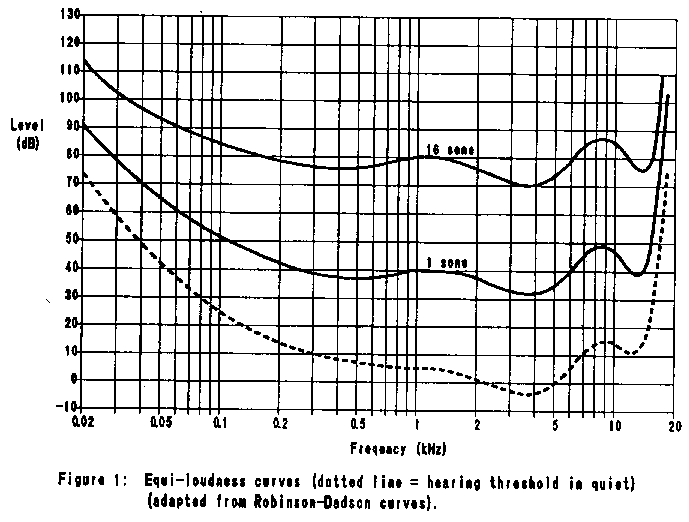
These curves indicate that the ear is more sensitive at some
frequencies than it is at others. Distortion at insensitive
frequencies will be less audible than at sensitive frequencies.
2.2 Masking
Masking [7] occurs when one sound is rendered inaudible by another.
Simultaneous masking occurs when the two sounds occur at the same
time, such as when a conversation (the masked signal) is rendered
inaudible by a passing train (the masker). Backward masking occurs
when the masked signal ends before the masker begins; forward masking
occurs when the masked signal begins after the masker has ended.
Masking becomes stronger as the two sounds get closer together in both
time and frequency. For example, simultaneous masking is stronger
than either forward or backward masking because the sounds occur at
the same time. Masking experiments are generally performed by using a
narrow band of white noise as the masking signal, and measuring the
just-audible level of a pure tone at various times and frequencies.
Examples of simultaneous masking and temporal masking are shown in
Figure 2 and Figure 3 respectively.
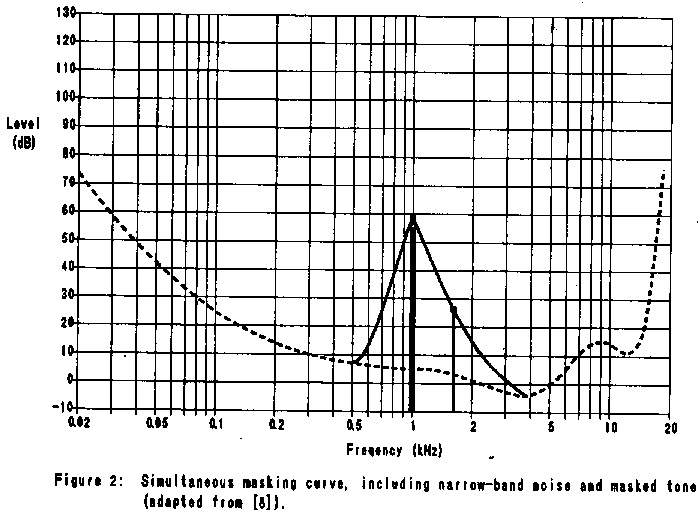
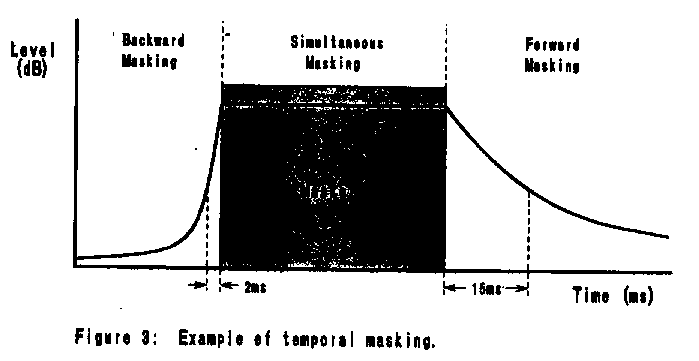
Important conclusions may be drawn from these graphs. First,
simultaneous masking is more effective when the frequency of the
masked signal is equal to or higher than that of the masker. Second,
while forward masking is effective for a considerable time after the
masker has stopped, backwards masking may only be effective for less
than 2 or 3 ms before the onset of the masker.
2.3 Critical Bands
Critical bands [7] arose from the idea that the ear analyzes the
audible frequency range using a set of subbands. The frequencies
within a critical band are similar in terms of the ear's perception,
and are processed separately from other critical bands. Critical bands
arose naturally from experiments in human hearing and can also be
derived from the distribution of sensory cells in the inner ear.
Critical bands can be thought of as the frequency scale used by the
ear [8].
The critical band scale is shown in Table 1. It is clear that the
critical bands are much narrower at lower frequencies than at high
frequencies; in fact, three quarters of the critical bands are located
below 5 kHz. This indicates that the ear receives more information from
the low frequencies and less from higher frequencies.
Table 1: Discrete critical bands [7]
Critical
Band |
Frequency (Hz) |
Critical
Band |
Frequency (Hz) |
| Low | High | Width |
Low | High | Width |
| 0 | 0 | 100 | 100 |
13 | 2000 | 2320 | 320 |
| 1 | 100 | 200 | 100 |
14 | 2320 | 2700 | 380 |
| 2 | 200 | 300 | 100 |
15 | 2700 | 3150 | 450 |
| 3 | 300 | 400 | 100 |
16 | 3150 | 3700 | 550 |
| 4 | 400 | 510 | 110 |
17 | 3700 | 4400 | 700 |
| 5 | 510 | 630 | 120 |
18 | 4400 | 5300 | 900 |
| 6 | 630 | 770 | 140 |
19 | 5300 | 6400 | 1100 |
| 7 | 770 | 920 | 150 |
20 | 6400 | 7700 | 1300 |
| 8 | 920 | 1080 | 160 |
21 | 7700 | 9500 | 1800 |
| 9 | 1080 | 1270 | 190 |
22 | 9500 | 12000 | 2500 |
| 10 | 1270 | 1480 | 210 |
23 | 12000 | 15500 | 3500 |
| 11 | 1480 | 1720 | 240 |
24 | 15500 | 22050 | 6550 |
| 12 | 1720 | 2000 | 280 |
| | | |
3 The ATRAC Encoder
A block diagram of the encoder structure is shown in Figure 4. The
encoder has three components. The analysis block decomposes the signal
into spectral coefficients grouped into Block Floating units (BFU's).
The bit allocation block divides the available bits between the BFU's,
allocating fewer bits to insensitive units. The quantization block
quantizes each spectral coefficient to the specified wordlength.
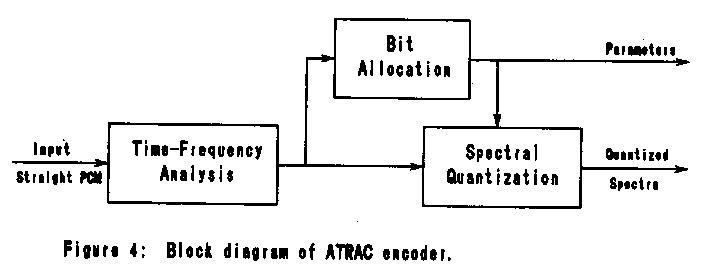
3.1 Time-Frequency Analysis
This block (Figure 6) generates the BFU's in three steps, combining
techniques from subband coding and transform coding. First, the signal
is broken down into three subbands: 0-5.5 kHz, 5.5-11 kHz, and 11-22
kHz. Each of these subbands is then transformed into the frequency
domain, producing a set of spectral coefficients. Finally, these
spectral coefficients are grouped nonuniformly into BFU's.
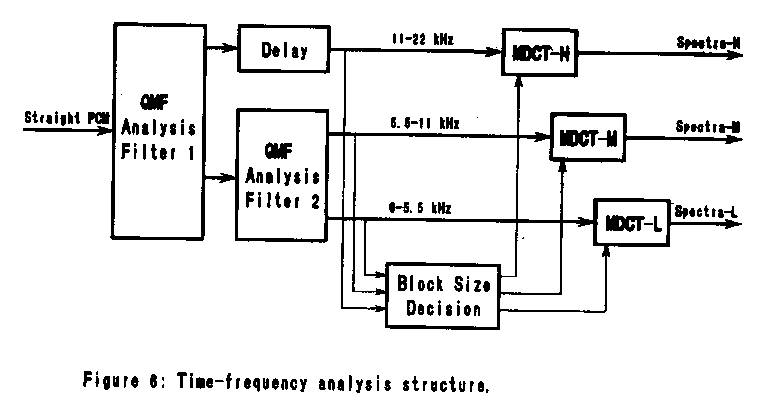
The subband decomposition is performed using Quadrature Mirror Filters
(QMF's) [0-10]. The input signal is divided into upper and lower
frequency bands by the first QMF, and the lower frequency band is
divided again by a second QMF. Use of QMF's ensures that time-domain
aliasing caused by the subband decomposition will be cancelled during
reconstruction.
Each of the three subbands is then transformed into the frequency
domain using the Modified Discrete Cosine Transform (MDCT) [11-12].
The MDCT allows up to 50% overlap between time-domain windows, leading
to improved frequency resolution while maintaining critical sampling.
Instead of a fixed transform block length, however, ATRAC chooses the
block length adaptively based on the signal characteristics in each
band. There are two modes: long mode (11.6 ms) and short mode (1.45 ms
in the high frequency band, 2.9 ms in the others). Normally long mode
is used to provide good frequency resolution. However, problems may
occur during attack portions of the signal. Specifically, the
quantization noise is spread over the entire signal block, and the
initial quantization noise is not masked (Figure 8a); this problem is
called pre-echo. In order to prevent pre-echo, ATRAC switches to short
mode (Figure 8b) when it detects an attack signal. In this case,
because there is only a short segment of noise before the attack, the
noise will be masked by backward masking (section 2.2). Backward
masking is not effective for Long Mode because of its very short
duration. Thus, ATRAC achieves efficient coding in stationary regions
while responding quickly to transient passages.
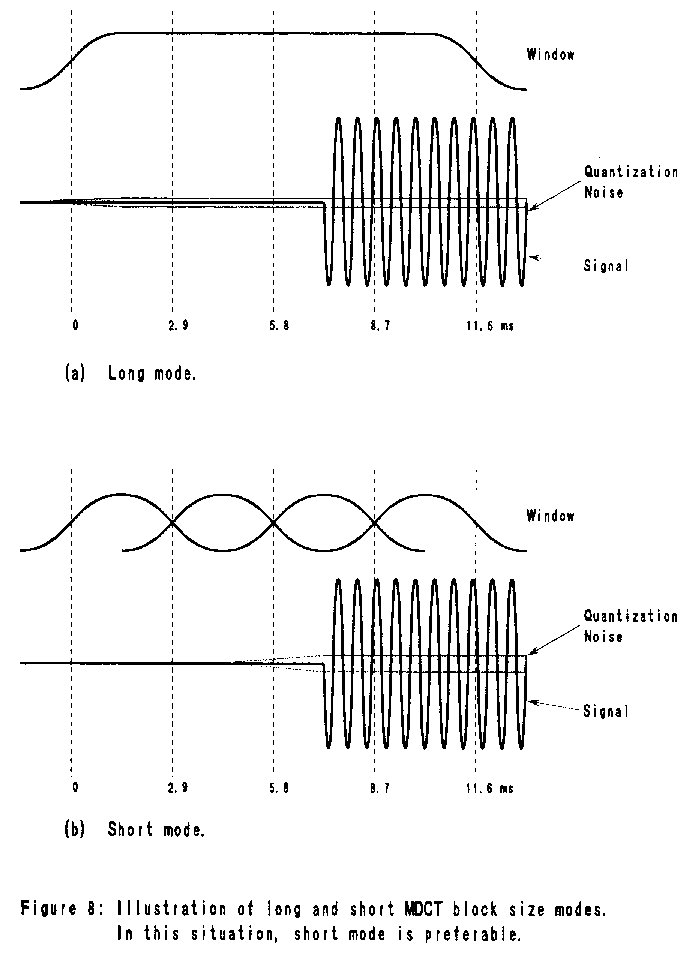
Note that short mode is not necessary for signal decay, because the
quantization noise will be masked by forward masking which lasts much
longer than backward masking. For maximum flexibility, the block size
mode can be selected independently for each band.
The MDCT spectral coefficients are then grouped into BFU's. Each unit
contains a fixed number of coefficients. In the case of long mode, the
units reflect 11.6 ms of a narrow frequency band; in the case of short
mode, each block reflects a shorter time but a wider frequency band
(Figure 9). Note that the concentration of BFU's is greater at low
frequencies than at high frequencies; this reflects the psychoacoustic
characteristics of the human ear.
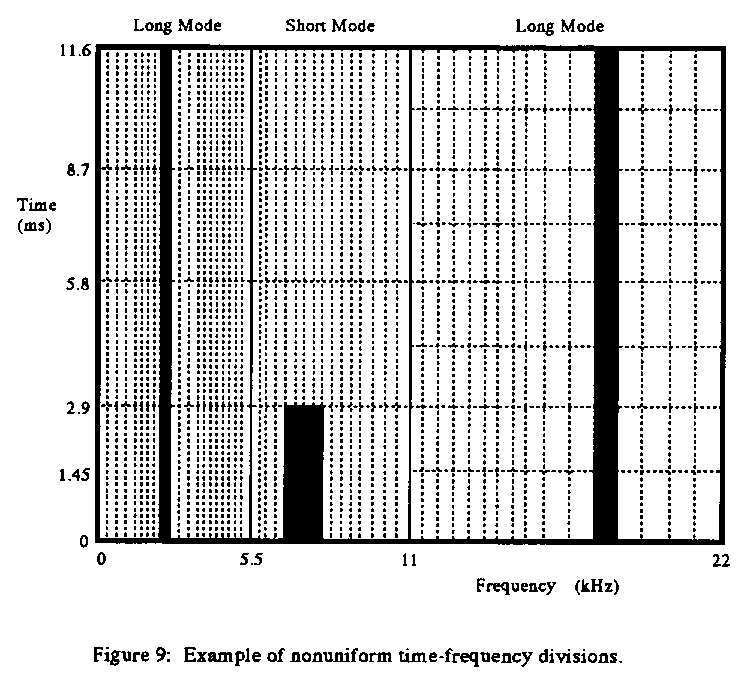
3.2 Spectral Quantization
The spectral values are quantized using two parameters: wordlength and
scale factor. The scale factor defines the full-scale range of the
quantization, and the wordlength defines the precision within that
scale. Each BFU has the same wordlength and scale factor, reflecting
the psychoacoustic similarity of the grouped frequencies.
The scale factor is chosen from a fixed list of possibilities, and
reflects the magnitude of the spectral coefficients in each BFU. The
wordlength is determined by the bit allocation algorithm (section
3.3).
For each sound frame (corresponding to 512 input points), the
following information is stored in disc:
- MDCT block size mode (long or short).
- Wordlength data for each Block Floating unit.
- Scale factor code for each Block Floating unit.
- Quantized spectral coefficients.
In order to guarantee accurate reconstruction of the input signal,
critical data such as the block size mode, wordlength and scale factor
data may be stored redundantly. Information about quantities of
redundant data is also stored on the disc.
3.3 Bit Allocation
The bit allocation algorithm divides the available data bits between
the various BFU's. Units with a large number of bits will have little
quantization noise; units with few or no bits will have significant
quantities of noise. For good sound quality, the bit allocation
algorithm must ensure that critical units have sufficient bits, and
that the noise in non-critical units is not perceptually significant.
ATRAC does not specify a bit allocation algorithm; any appropriate
algorithm may be used. The wordlength of each BFU is stored on the
MiniDisc along with the quantized spectra, so the decoder is
completely independent of the allocation algorithm. This provides for
the evolutionary improvement of the encoder without changing the
MiniDisc format or the decoder.
There are many possible algorithms, ranging from very simple to
extraordinarily complex. For portable MiniDisc recorders, however, the
possibilities are limited somewhat by the fact that they must be
implemented on low-cost low-power compact hardware. Nevertheless,
ATRAC is capable of good sound quality using even a simple bit
allocation algorithm, provided it is soundly based on psychoacoustic
principles. ATRAC's nonuniform adaptive time-frequency structure is
already based on psychoacoustics, relieving the pressure on the bit
allocation algorithm.
One suggested algorithm uses a combination of fixed and variable bits.
The fixed bits emphasize the important low-frequency regions,
allocating fewer bits to the BFU's in higher frequencies. The variable
bits are allocated according to the logarithm of the spectral
coefficients within each BFU. The total bit allocation btot
is the weighted sum of the fixed bits bfix(k) and the
variable bits bvar(k). Thus, for each BFU k,
btot(k) = Tbvar +
(1-T)bfix
The weight T is a measure of the tonality of the signal, taking
a value close to 1 for pure tones, and close to 0 for white noise.
This means that the proportion of fixed and variable bits is itself
variable. Thus, for pure tones, the available bits will be
concentrated in a small number of BFU's. For more noise-like signals,
the algorithm will emphasize the fixed bits in order to reduce the
number of bits allocated to the insensitive high frequencies.
The above equation is not concerned with
overall bit rate, and will in general allocate more bits than are
available. In order to ensure a fixed data rate, an offset
boff (the same for all BFU's) is calculated. This
value is subtracted from btot(k) for each unit,
giving the final bit allocation b(k):
b(k) =
integer{btot(k)-boff}
If the subtraction generates a negative wordlength, that BFU is
allocated 0 bits. This algorithm is illustrated in Figure 10.
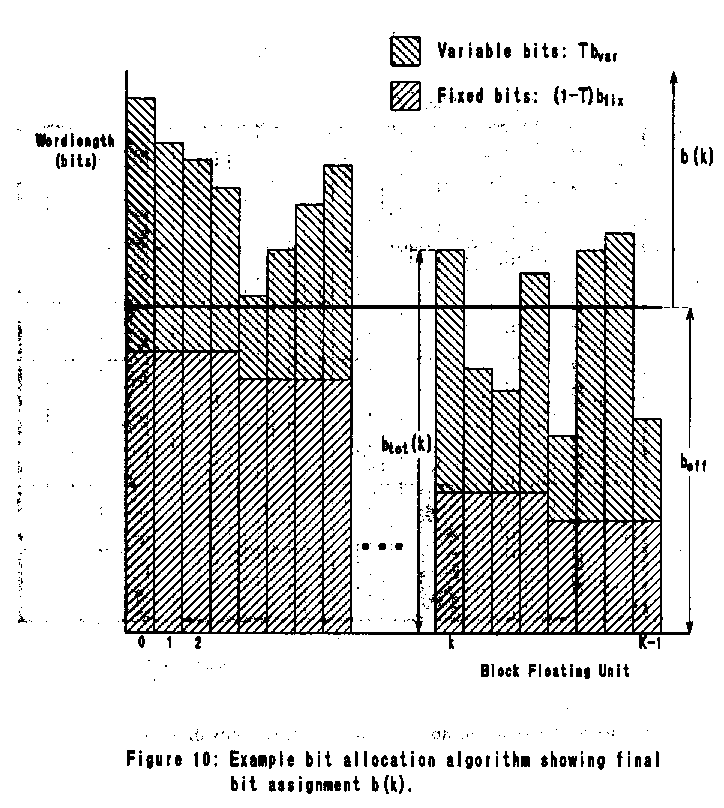
4 The ATRAC Decoder
A block diagram of the decoder structure is shown in Figure 5. The
decoder first reconstructs the MDCT spectral coefficients from the
quantized values, using the wordlength and scale factor parameters.
These spectral coefficients are then used to reconstruct the original
audio signal (Figure 7). The coefficients are first transformed back
into the time domain by the inverse MDCT (IMDCT) using either long
mode or short mode as specified in the parameters. Finally, the three
time-domain signals are synthesized into the output signal by QMF
synthesis filters.
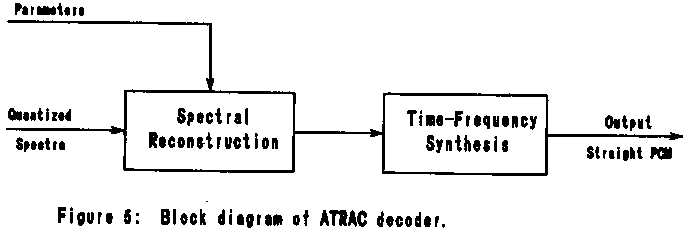
5 Conclusions
Through a combination of various techniques including psychoacoustics,
subband coding and transform coding, ATRAC succeeds in coding digital
audio with virtually no perceptual degradation in sound quality.
Listening tests indicate that the difference between ATRAC sound and the
original source is not perceptually annoying nor does it reduce the
sound quality. Furthermore, the system is sufficiently compact to be
installed in portable consumer products. Using ATRAC, the MiniDisc
provides a practical solution for portable digital audio.
6 References
- MPEG/AUDIO CA11172-3, 1992.
- "ASPEC (Source: AT&T Bell Labs et al. )" Doc. No. 89/205, ISO-IEC
JTC1/SC2/WG8 MPEG-AUDIO, Oct. 18, 1989.
- R. Veldhuis, M. Breeuwer and R. van der Wall, "Subband coding of
digital audio signals without loss of quality," Proc. 1989
International Conference on Acoustics, Speech and Signal Processing,
Glasgow, pp. 2009-2012.
- A. Sugiyama, F. Hazu, M. Iwadare and T. Nishitani, "Adaptive
transform coding with an adaptive block size (ATCABS)," Proc. 1990
International Conference on Acoustics, Speech and Signal Processing,
Albuquerque, pp. 1093-1096.
- G. Davidson, L. Fielder and M. Antill, "High-quality audio
transform coding at 128 kbits/s," Proc. 1990
International Conference on Acoustics, Speech and Signal Processing,
Albuquerque, pp. 1117-1120.
- G. Davidon, L. Fielder and M. Antill, "Low-complexity transform
coder for satellite link applications," Audio Engineering Society 89th
Convention preprint 2966, Sept. 1990.
- J. S. Tobias, Ed., Foundations of Modern Auditory Theory, Vol. 1,
Academic Press, New York, 1970.
- E. Zwicker and U. T. Zwicker, "Audio engineering and
psychoacoustics: Matching signals to the final receiver, the human
auditory system." J. Audio Engineering Society, Vol. 39 No. 3, pp.
115-126, March 1991.
- D. Estaban, and C. Galand, "Application of quadrature mirror
filters to split band voice coding schemes," Proc. 1977 IEEE
International Conference on Acoustics, Speech and Signal Processing,
Hartford CT, pp. 191-195.
- P. P. Vaidyanathan, "Quadrature mirror filter banks, M-band
extensions and perfect-reconstruction techniques," IEEE ASSP Magazine,
Vol. 4, pp. 4-20, July 1987.
- J. Princen and A. Bradley. "Analysis/synthesis filter band design
based on time-domain aliasing cancellation," IEEE Trans. Acoustics,
Speech and Signal Processing, Vol. 34, pp. 1153-1161, 1986.
- J. Princen, A. Johnson and A. Bradley, "Subband/transform coding
using filter band designs based on time domain aliasing cancellation,"
Proc. 1987 IEEE International conference on Acoustics, Speech and
Signal Processing, Dallas, pp. 2161-2164.
Translations:
~ No further translations needed, thank you! ~









